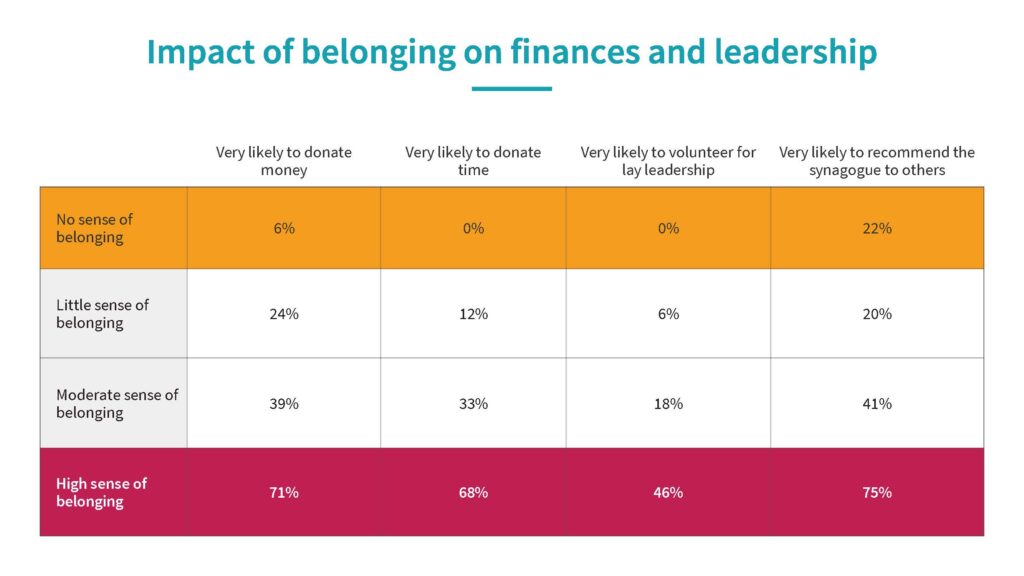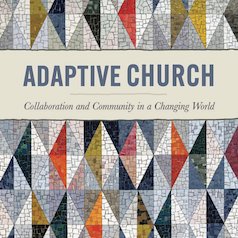Start with Belonging
Start with Belonging
This guest article is written by Rabbi Julia Appel, Senior Director of Innovation, Clal – The National Jewish Center for Learning and Leadership. Rabbi Appel participated in our Executive Certificate in Religious Fundraising course in 2022.
by Rabbi Julia Appel
It sometimes feels like there are two opposing views about how to strengthen a congregation. The first, let’s call it a personal approach, looks to the spiritual engagement of congregants, the relationships between them, and how they feel. The second, let’s call it a technical approach, looks to increasing membership or donor numbers, the success of capital campaigns to raise funds to support the building, or increasing attendance at major events and services. The personal approach can feel to some like it’s too “fluffy,” unspecific, or hard to measure. The technical approach can feel to some like it’s too calculated or disconnected from congregational mission. At board or staff meetings, advocates of either approach to defining the health of the congregation can feel like they are speaking different languages.
The Belonging Project
In our research, I and my organization Clal have found that these two approaches are in fact deeply correlated with one another. If you read this newsletter, you probably already believe that relationships are key to religious fundraising. Additionally, though, we have found that investing in activities that promote belonging can have significant impact not only on community-building, but on fundraising success. For the last year, Clal has been developing The Belonging Project, a training program for synagogues to increase the feeling of belonging and connection among congregants. Part of the training includes an initial congregational survey, developed with our partner the Springtide Research Institute. The survey measures belonging across four stages of belonging (being noticed, being named, being known, and being needed), as well as how different program areas impact a congregant’s sense of belonging. We are also able to trace belonging across a number of demographic categories.
The most striking finding from our pilot survey was just how deeply a congregant’s sense of belonging correlated with their likelihood to contribute to the congregation. Our pilot cohort used the survey with their synagogues in June 2022, reaching almost 1,100 congregants across 7 congregations of varying size and Jewish denomination. We found that there was a vast difference between those with no sense of belonging and those with a high sense of belonging when it comes to their likelihood to donate money, to donate their time, to volunteer in lay leadership positions (like a board or committee), and to recommend the synagogue to others.
 Start with Belonging
Start with Belonging
For congregations seeking to reinvigorate financial and volunteer investment in the congregational community, the implications are profound. Our tendency might be to increase our marketing, increase the number of donation asks, or create elaborate fundraising campaigns. However, it would seem from the data above that it would be extremely important to pair that with doubling down on relationship-building and creating a sense of belonging and home for as many congregants as possible: this, it seems, will also grow their desire to contribute.
If you’re interested in trying this route, your congregation could start by asking yourselves some of the following questions:
- How might we restructure congregational activities away from frontal lectures or large, impersonal events, offering more ongoing, small group opportunities for congregants to really get to know each other? These opportunities create relationship between people.
- Could our volunteer opportunities and board membership experience be structured more around making friends, building camaraderie, and sharing values, instead of only focusing on getting things done? This helps people feel they are part of a mission together and to feel their contributions are done in community.
- How can we help congregants learn each others’ names and stories, and incorporate that throughout our congregational offerings? This helps people feel seen and known.
- Can we increase our opportunities for congregants to share hardships, challenges, and personal growth with each other – for example, through grief support groups, life-stage-specific classes, and volunteer groups to care for the sick or those with new babies? This helps people feel supported and like they support others.
- Do we have clear and easy ways for our congregants to volunteer in the life of the community, at a variety of time commitment levels? This lets congregants know their unique skills and talents are needed, and it enables them to contribute no matter their time capacity.
In order to create thriving congregations, we need to remember that these two seemingly different approaches are two parts of the same whole. Investing in a new ongoing support group or a sit-down lunch discussion after services could be just as effective as a direct-mail campaign, if not more so. Activities that produce donations aren’t confined to traditional fundraising methods, it turns out. See what happens if you start with belonging.
Questions for Reflection
-
- How important is a sense of belonging for your own giving and serving? What makes you feel you ‘belong’?
- Pick one of the questions Rabbi Appel includes in this article and bring it to your next staff meeting for discussion.
Expanded Perspective
by Anne Brock
Belonging is in the zeitgeist. In addition to The Belonging Project that Rabbi Appel referenced, I also know of another identically named The Belonging Project. In googling the name, I discovered a full page of other similarly named projects. Even the US Surgeon General notes the “loneliness epidemic” steadily increasing in the United States, with dramatic negative health implications for people less connected to “worship houses, community organizations and even their own family members in recent decades.” Isolation, and its antidote, belonging, seems to be everywhere as we look ahead past the public health emergency stage of the pandemic.
Maybe it’s because we took belonging for granted for so long. I know of congregations who didn’t work very hard at reaching out to those who had stopped attending (me!). Like the character of King George sings in the musical Hamilton, I think they assumed, “You’ll be back, soon, you’ll see / You’ll remember you belong to me.” But once the covid pandemic hit, some people realized (me!) that the need to belong to a congregation – attending week after week – could be met in other ways. Several years later, I’m finding my way back into a local congregation and part of that is because people remember my name. A seemingly small gesture is one big step toward belonging.
Research has consistently shown that attendance at religious services is a significant predictor in levels of religious giving. With higher levels of attendance, we often see higher levels of giving. While not the best measure of belonging, attendance has often serves as the best measure researchers often have within congregations. Yet, when we look at other measures of engagement (e.g. being part of a small group, singing in the choir, teaching children or youth, we see even stronger overlaps with giving). Beyond just attendance, deeper levels of engagement and belonging demonstrate higher levels of giving and volunteering. It’s clear: faith and giving are tied up with belonging and relationships. It’s a key factor for the relationship between faith and giving to consider how to foster belonging, especially as attendance continues to experience significant decreases in many congregations. Below we’ve shared other resources related to belonging, faith, and, ultimately, giving.
The Belonging Project (from Clal): A cutting edge initiative that merges scientific research, relational best practices, and ancient Jewish wisdom.
The Belonging Project (from Crisis and Care): Originating from authors and thought partners of the volume, Crisis and Care: Meditations on Faith and Philanthropy, The Belonging Project is the next step in responding with care to the question of the moment.
The Belonging Project (from Stanford): “The Belonging Project at Stanford” is a broadly-engaged, multidimensional effort to promote emotional health and personal wellbeing through connection with the communities of our campus and beyond.
Belonging: This special issue of the Presbyterian Outlook examines the concept of belonging from a variety of perspectives to help us address what some are calling an “epidemic” of isolation in today’s society.
Belonging: The Science of Creating Connection and Bridging Divides: In Belonging, Stanford University professor Geoffrey L. Cohen applies his and others’ groundbreaking research to the myriad problems of communal existence and offers concrete solutions for improving daily life at work, in school, in our homes, and in our communities.
Innovative Giving
We have collected stories from a variety of congregations — small and large, urban and rural, plus different faith traditions — who have sought to use their assets and resources in creative ways as an expression of faithful giving.
One of the collections is focused on Innovative Giving. Explore how congregations reduce medial debt, respond to a water crisis, seek a path to reparations, and more.
Adaptive Church
Adaptive Church explores what it takes for communities of faith to respond to uncertainty and shifting organizational environments. Based on fifty-two interviews and four years of empirical work, Dustin Benac charts a theological paradigm for collaboration and community in a changing world. Adaptive Church provides a template for change within and beyond the forms that have historically guided Christian organization, education, and leadership.
Subscribe
Insights is a bi-weekly e-newsletter for the religious community and fundraisers of faith-based organizations that provides:
- Reflections on important developments in the field of faith and giving
- Recommended books, studies and articles
- Upcoming Lake Institute events



